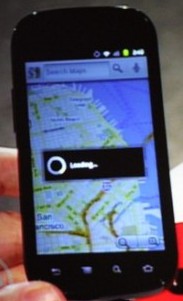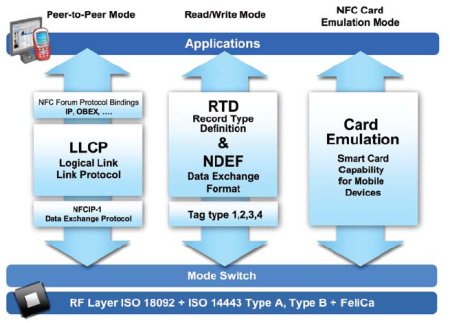NFC heads for Android and new commerce network
Nov 17, 2010 — by LinuxDevices Staff — from the LinuxDevices Archive — viewsVerizon Wireless, AT&T, and T-Mobile announced a new “Isis” venture that will roll out a mobile commerce network based on smartphones embedded with near field communications (NFC) networking chips. Isis supporters include Apple and Nokia, as well as Google, which revealed this week that Android 2.3 will add support for short-range NFC wireless communications.
Rival carriers Verizon Wireless, AT&T, and T-Mobile will be working together to create a "national commerce network that aims to fundamentally transform how people shop, pay and save," the three announced Nov. 16.
The venture, called Isis, relies on smartphones and NFC (near field communications), which uses short-range, high-frequency wireless technology to pass encrypted information between devices. In countries such as Japan, consumers have used such a service — which essentially turns one's smartphone into a wallet — for several years now.

Number of mobile ticket deliveries by region through 2014
Source: Juniper Research (Feb. 2010)
Michael Abbott, formerly with GE Capital, has been tapped to lead Isis, which is expected to roll out its service to "key geographic markets" over the next 18 months. Isis, effective as of Nov. 16, will be based in New York.
"Our mobile commerce network, through relationships with merchants, will provide an enhanced, more convenient, more personalized shopping experience for consumers," Abbott said in a statement. "While mobile payments will be at the core of our offering, it is only the start. We plan to create a mobile wallet that ultimately eliminates the need for consumers to carry cash, credit and debit cards, reward cards, coupons, tickets and transit passes."
Between them, AT&T, T-Mobile, and Verizon offer wireless service to more than 200 million customers, who will have access to Isis. Currently, Isis is working with Discover Financial Services' payment network to develop an infrastructure for the program. Barclaycard US is expected to be the first issuer on the Isis network, offering mobile payment products.
"We believe the venture will have the scope and scale necessary to introduce mobile commerce on a broad basis," said Abbott. "In the beginning, we intend to fully utilize Discover's national payment infrastructure as well as Barclaycard's expertise in contactless and mobile payments. Moving forward, Isis will be available to all interested merchants, banks and mobile carriers."
Earlier this year, Juniper Networks released a report, projecting that NFC represented the future for a mobile-ticketing market that will reach 15 billion tickets by 2014. (See farther below for NFC background.)
 Google: Android 2.3 will add NFC support
Google: Android 2.3 will add NFC support
The day before the Isis announcement, Google CEO Eric Schmidt — while showing off a device expected to be the Nexus S at the Web 2.0 Summit in San Francisco — explained that Android 2.3, or "Gingerbread," will leverage NFC technology, working with an embedded chip in the phone and a mobile application. (A Phandroid photo of Schmidt's phone may be seen at right.)
"The theory of the case is that you'll be able to take these mobile devices from everybody, and you'll be able to walk into a store and do commerce and be able to figure out where you are, again with your permission," Schmidt said. "It could eventually literally replace your credit card."
He added that NFC uses a higher level of authentication than the traditional credit card magnetic stripe, making it more secure.
Apple is also preparing to get in on the action, and in August hired an NFC expert as its new product manager for mobile commerce, Apple also published a number of NFC-related patents over the summer.
In addition, Nokia — no stranger to NFC, having launched a trial NFC payment plan in China in 2006, among other efforts — plans to push out an upgrade to its Symbian 3-based C7 smartphone in early 2011, enabling the device to handle NFC tag reading, reported Near Field Communications World Nov. 14, citing the French site Teknologik.
"Any time major industry players agree on a step forward, it's a great step for all involved, especially consumers," Nokia spokesperson Joseph Gallo told eWEEK. "In this case, with regard to NFC, it adds further value to the handset and ultimately the consumer, by allowing access to new services and digital content on their mobile easily and conveniently."
The ability to easily share content such as business cards and photos, or to use an NFC mobile device as a travel card, ticket or loyalty card, Gallo explained, "adds to the consumer's emotional attachment to the device."
Bling Nation, a company that uses contactless stickers, called Bling Tags, on the back of mobile phones, has recently been running a mobile payment trial with PayPal. It will roll out its solution in early 2011, Forbes reported Nov. 15.
The Bling technology is compatible with NFC technology, and so will work with NFC phones, Forbes reports, adding that the company is currently in negotiations with handset manufacturers to incorporate the technology directly into their handsets.
NFC background
Promoted by the NFC Forum, near field communications is designed to offer a more power-efficient and affordable alternative to Bluetooth for very short-range, low-bandwidth applications. It is also touted as providing a more robust, bandwidth-rich alternative to RFID and other "contactless" technologies.

NFC architecture
Source: NFC Forum
(Click to enlarge)
Michelle Maisto is a writer for our sister publication eWEEK.
This article was originally published on LinuxDevices.com and has been donated to the open source community by QuinStreet Inc. Please visit LinuxToday.com for up-to-date news and articles about Linux and open source.